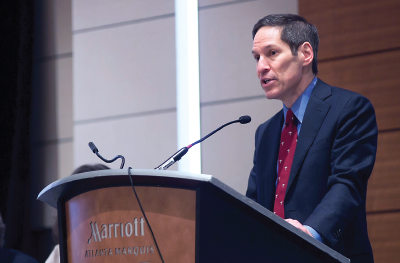AMA Tackles Opioid Abuse Prevention, Urges Use of Drug Monitoring Programs
Abstract
Physicians urge clinicians to educate themselves about the treatment of chronic pain and the range of behavioral and psychosocial approaches that can be used.
Registering for and making active use of state prescription drug monitoring programs (PDMPs) is the most potent tool clinicians have at their disposal to combat the opioid addiction and overdose epidemic, said public health experts during an educational session on opioid abuse at last month’s meeting of the AMA House of Delegates in Atlanta.
The experts urged physicians at the meeting to educate themselves about pain management and promote safe, responsible opioid prescribing; support overdose prevention measures, such as increased access to naloxone; and work to overcome stigma associated with substance use disorder and ensure patients in pain aren’t stigmatized and can receive comprehensive treatment.

Psychiatrist Patrice Harris, M.D., M.A., urges physicians to register for their state prescription drug monitoring program. The programs offer valuable historical information about a patient’s prescription drug history.
Chairing the panel was psychiatrist Patrice Harris, M.D., M.A., chair-elect of the AMA Board of Trustees and chair of the AMA’s Task Force to Reduce Opioid Abuse. Panelists included Thomas Frieden, M.D., M.P.H., director of the Centers for Disease Control and Prevention; Sharon Meieran, M.D., J.D., emergency psychiatric services lead physician at Kaiser Sunnyside and Westside Medical Centers; Daniel Carr, M.D., president-elect of the American Academy of Pain Medicine; and Richard Soper, M.D., J.D., medical director of the Center for Behavioral Wellness in Nashville, Tenn.
The most consistent message throughout the educational session was the imperative for physicians to participate in their state’s PDMP. PDMPs are state-run electronic databases used to track the prescribing and dispensing of controlled prescription drugs to patients; they are designed to monitor this information for suspected abuse or diversion—that is, channeling drugs for illicit sale and use—and can give a prescriber or pharmacist critical information regarding a patient’s controlled-substance prescription history.
“Physicians need to register for their state PDMP,” Harris said. “They are not perfect, but they are a tool we can use. Even if the information is not real time, at least clinicians can have some historical data [about a patient] to help inform their prescribing.”
Meieran called PDMPs “a very valuable tool in the risk-benefit analysis of prescribing opioids.” Of the 49 states that have authorized the monitoring programs, 42 are actively using them. “It takes about 10 seconds to check [the PDMP for a patient’s record],” she said. “I have been surprised in both directions—there are people I would never suspect who are abusers, and others I would have suspected who have no record at all. You don’t know what you don’t know.”
She added, “Physicians have a significant responsibility to address the situation as it stands today. The evidence is clear that opioids are not always effective but do cause substantial harm in many cases.”
Soper and Carr emphasized that there is a range of behavioral and psychosocial treatments for chronic pain in addition to prescription painkillers. “There are better and more comprehensive ways [to treat chronic pain] that incorporate a range of community-based elements,” Soper said. “We need to provide access to these services and reduce the stigma associated with chronic pain. Chronic disease management needs to be central to policy development. For physicians, the best advice is to start at the beginning by keeping opioid-naïve patients naïve.”

Thomas Frieden, M.D., director of the CDC, said the overprescription of opioid painkillers has contributed in complex ways to the increase in heroin use and heroin overdoses.
Frieden emphasized the widening scope of the opioid-abuse epidemic and its overlap with heroin abuse and overdose and with other diseases. “The death rates traditionally have been falling for all groups, but we are seeing rates for some age groups rising, and the key cause is opioid overdose,” Frieden said. “We are also seeing a rise in suicides, some of which are related to addiction.
“For every one person who dies from an overdose, there are 12 who are admitted [to hospital emergency departments] for it,” Frieden continued. He noted that in a small rural county in Indiana—with a population of just 4,300 and a single case of HIV—drug use and needle sharing resulted in more than 180 cases of HIV in just over a few months. “That’s a horrific outbreak in a town of 4,300,” he said.
Frieden emphasized that the spike in heroin deaths is related in complex ways to the overprescription of opioid pain killers. “Three of four people using heroin began with prescription opioids,” he said. “The latter is a gateway drug. As we have tightened up on prescribing, people who have become addicted have gone in search of heroin.”
Frieden also addressed the issue of patient-satisfaction surveys that are incorporated into physician quality reporting; drug-seeking patients can be demanding and will leave “dissatisfied” when physicians don’t comply with their requests for painkillers. “We need to have a clear conversation and work together with different organizations that do quality rating about the comprehensive and holistic assessment of chronic pain.”
Physicians at the educational session also urged the use of naloxone for patients at risk of overdose. Immediately following the House of Delegates meeting, the Food and Drug Administration (FDA) approved a nasal spray version of the drug.
“The FDA’s swift action will widely increase accessibility to this medication, which will help prevent more opioid-related overdoses and save more lives,” said Harris in a statement. “The AMA has long advocated in support of a multipronged approach to addressing prescription drug abuse and diversion, which includes increasing access to naloxone for patients who need it.
“With 44 people dying each day from opioid-related overdose, we are committed to expanding our efforts aimed at addressing prescription drug abuse and diversion and putting an end to this serious public health epidemic.” ■
Information on how physicians can prevent opioid abuse can be accessed here.



